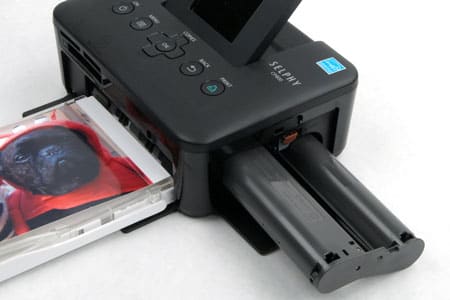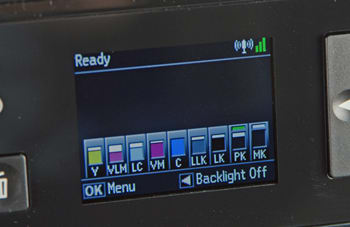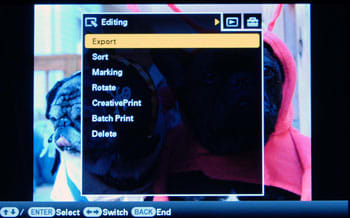Introduction
Front
{{section_header}}{{section.name}}{{/section_header}}

Sides
{{section_header}}{{section.name}}{{/section_header}}

Back
{{section_header}}{{section.name}}{{/section_header}}

Ink Cartridges
{{section_header}}{{section.name}}{{/section_header}}
The {{product.name}} uses the oft relied-upon HP 110 ink cartridge, used primarily for compact photo printer by HP. While the included cartridge lasted about 35 prints in the lab, you can buy cartidges at your local electronics store that have higher capacity for about $25 (or less online).

In the Box
{{section_header}}{{section.name}}{{/section_header}}
As well as the printer itself, the tote bag case of the {{product.name}} contains:
A power cable.
An ink cartridge.
A few sheets of HP photo paper.
Assorted documentation
Though it's not exactly a conventional case, the packaging of the {{product.name}} is actually a tote bag to carry around your new compact printer. This could be good for those times when you go to a gathering that absolutely needs photos printed right now.

Performance
The {{product.name}} does a great job with color accuracy, and has decent depth of blacks and color gamut.
Photo Print Speed
{{section_header}}{{section.name}}{{/section_header}}
No speed demon, the {{product.name}} takes roughly 77 seconds per 4" x 6" print, and even longer for 5" x 7" prints, which is uninspiring to say the least. Still, the resulting picture has good color accuracy, so it's not as if there is no advantage to printing photos with {{product.name}}. More on how we test print speed.
{{comparison_bars title="Photo Speed Score Comparison", attribute="Photo Speed Score", xLabel="Photo Speed Score"}}
Color Accuracy
{{section_header}}{{section.name}}{{/section_header}}
Despite their somewhat limited function, the {{product.name}} can actually employ new printer profiles, and it benefits greatly from that; giving users a stupendously low color error. As far as photo printers go, this little compact is a tiny powerhouse of color accuracy. More on how we test color accuracy.
Compared to other compacts, the {{product.name}} holds up very well, only matched closely by the Epson PM 225. Still, it's hard to ask much more of a compact photo printer.
Camera Color Comparisons

NOTE: Because of the way computer monitors reproduce colors, the images above may not match the results used for evaluating color accuracy. The chart should be used to judge the relative color shift, not the exact printed colors.
Color Gamut
{{section_header}}{{section.name}}{{/section_header}}
A stunning result to be sure, the {{product.name}} manages to reproduce 69.9% of the entire Adobe 1998 color gamut, which is very impressive when it comes to any printer, not just a compact.You should have no difficulty reproducing a wide range of color values with the {{product.name}}. More on how we test color gamut.
Depth of Blacks
{{section_header}}{{section.name}}{{/section_header}}
Sample Scan Comparisons

The {{product.name}} impresses in depth of blacks with a DMax measure of 2.88, which is impressive for any printer, more so a compact. This score is important, as the deeper the blacks are, the wider the contrast ratio of your pictures will be, making it easier for the printer to re-create moments exactly as you remember them. More on how we test depth of blacks.
Detail
{{section_header}}{{section.name}}{{/section_header}}
Perhaps it's a function of trying to cram everything a printer needs into a tiny package, but the detail performance of the {{product.name}} is average at best.
Considering its performance in other areas, it's hard to complain, but you may notice a bit of detail loss in high-contrast patterns or gradients. Below are some scans to illustrate what we mean.
Notice how the ends of thin lines and sharp edges get lost in the print, making the picture suffer a loss of dilineation between black areas and white. Because of this, small details like the white hairs on the dog's forehead get completely crushed into the surrounding darker colors.
{{comparison_bars title="Detail Score Comparison", attribute="Detail Score", xLabel="Detail Score"}}
Usability
Able to print via USB or bluetooth connection, the {{product.name}} can start printing your photos very quickly from different sources. The added in-printer drivers allow you to plug'n'play, though the limited range of media is disappointing, but expected for a compact printer.
On-Printer Controls
{{section_header}}{{section.name}}{{/section_header}}
Aside from the power button, the majority of the on-printer controls are accessed through the resistive touch screen. To this end, the {{product.name}} has a plastic stylus to enable users to tap the screen without much frustration due to the size of their fingertips versus the small size of the LCD.

On-Printer Display
{{section_header}}{{section.name}}{{/section_header}}
Located on the top of the {{product.name}} is the rather large (for its size) resistive LCD touchscreen. This alson doubles as your main interface with the printer outside of a computer should you elect to use it. Using the stylus included with the printer, you can tap through different visually unappealing menus and settings.

The on-board screen is a nice touch
On-Printer Menus
{{section_header}}{{section.name}}{{/section_header}}
The touch menus of the {{product.name}} are easy to navigate with the stylus, and they are somewhat more visually appealing than what we've seen on other models of compact printers. The level of control over printer functions is adequate, but not terribly expansive.

The on-screen menu of the Sony DPP-F700
Media Slots
{{section_header}}{{section.name}}{{/section_header}}
The front of the {{product.name}} is home to the media ports available for use, though both of them are more multi-function than high in number. One port handles the MemoryStick family of media cards, and the other handles the SD/xD (with adapter) family of media cards.

The media slots of the Sony DPP-F700
Wireless & Network
{{section_header}}{{section.name}}{{/section_header}}
Much to users' delight, the {{product.name}} can be used over an 802.11b/g/n wireless network, but that's not even the coolest feature: not wanting to be left behind by other compact photos in the smartphone age, the {{product.name}} allows you to transmit pictures taken with your smartphone to the printer itself, which will then print said picture.

Setup & Manuals
{{section_header}}{{section.name}}{{/section_header}}
Setup of the {{product.name}} is very easy, minus missing the required cable. If you do have a type A to type B USB cable lying around, all you need to do is unpack the printer, plug it into the power source and computer, and install the software that pops up on your screen.
Drivers
{{section_header}}{{section.name}}{{/section_header}}
Unsurprisingly, the drivers of the {{product.name}} really don't offer much in the way of advanced control of your pictures, but that's really okay. You aren't going to be doing much other than printing 4x6 or 5x7 prints. Among the options that you can mess around with are layout, paper handling, and a couple (literally, 2) photo options.
Ink/Toner
{{section_header}}{{section.name}}{{/section_header}}
For simplicity's sake, the compact {{product.name}} uses only one CMY ink cartridge that can give you an estimated (by HP) 55 4" x 6" prints for a price of $23.99USD. Be wary that because there are no individual color cartridges, you are prone to see one color dry up faster than the others, making your pictures look quite bad. Replacing and installing the cartridge is easy enough, though.

Media
{{section_header}}{{section.name}}{{/section_header}}
Because of its diminutive size and limited functionality, the {{product.name}} can handle only 4" x 6" or 5" x 7" prints. Still, when you look at competitive compact photo printers, most don't seem to be able to handle 5" x 7" prints, so the {{product.name}} has that over similar models. Still, poor scoring here.
Paper Storage
{{section_header}}{{section.name}}{{/section_header}}
When you start opening up the {{product.name}} to start printing, the back door that pops open in the back is the paper tray. It can't hold much more than 15 sheets, but it's a compact printer; high volume in anything isn't its forte.

Sample Photos
{{section_header}}{{section.name}}{{/section_header}}
In the following sample images, clicking on the larger image will download the full resolution original.
Value Comparison
{{section_header}}{{section.name}}{{/section_header}}
In terms of value, it's hard to argue with a printer that does the same exact things as the printer in question but better, and cheaper too. For about $100 less than the A536, the A646 performs better across the board, and does just about everything the A536 can do. There's no contest here.
Color Comparison
{{section_header}}{{section.name}}{{/section_header}}
The A646 edges out the A536 in term of color accuracy, although it's not a dramatic difference. Still, the {{product.name}} is better.
Detail Comparison
{{section_header}}{{section.name}}{{/section_header}}
Both printers maintain roughly the same level of detail in photos, but they certainly have their issues. The {{product.name}} barely edges out the A536.
DMax Comparison
{{section_header}}{{section.name}}{{/section_header}}
Though the {{product.name}}'s dMax measure is fairly good, that of the A536 is uninspiring at best. Stick with the {{product.name}} for better contrast.
Color Gamut Comparison
{{section_header}}{{section.name}}{{/section_header}}
Both printers are fairly impressive in this regard, but the {{product.name}}'s gamut measure of 69.9% of the Adobe RGB color gamut is far better than the A536's.
Usability Comparison
{{section_header}}{{section.name}}{{/section_header}}
Both printers can print from smartphones, are very portable, and can print 4 x 6 as well as 5 x 7 inch photos. There is virtually no difference between the two outside of the fact that the {{product.name}} has a touchscreen.
Value Comparison
{{section_header}}{{section.name}}{{/section_header}}
Both are affordable printers that have their bright spots, but if connectivity is important to you, or if you require flexibility in printable media, take the {{product.name}}. Though the Epson blows every other printer away that we've reviewed so far in terms of performance, it can only do so on 4 x 6 prints. That's it. The {{product.name}} on the other hand, can print from a smartphone, computer, or media card, and can also do 5 x 7 prints if need be.
Color Comparison
{{section_header}}{{section.name}}{{/section_header}}
Both printers have very accurate colors, and nigh-identical scores in this regard.
Detail Comparison
{{section_header}}{{section.name}}{{/section_header}}
While neither printer impresses here, the Epson PM 225 manages to maintain a better level of detail than the {{product.name}}, maintaining a more even color gradient than the {{product.model}}.
DMax Comparison
{{section_header}}{{section.name}}{{/section_header}}
Though the {{product.name}}'s dMax measure is impressive, the Epson trounces almost every other printer we've ever had in this regard, so it's no surprise that it scores higher here.
Color Gamut Comparison
{{section_header}}{{section.name}}{{/section_header}}
Despite the {{product.name}}'s impressively massive color gamut, the PM 225 outshines the {{product.name}} again, measuring in with a 75%+ recreation of the Adobe RGB color gamut.
Value Comparison
{{section_header}}{{section.name}}{{/section_header}}
Perceived value of each printer has largely to do with what you value in a printer. If you're looking for instant prints like the Polaroids of old, the new Z340 is a great pickup. It can't perform on the level of the {{product.name}}, but it does provide you with convenient and quick prints. If you want something you can hang or frame, you're going to want the {{product.name}} instead.
Color Comparison
{{section_header}}{{section.name}}{{/section_header}}
The Polaroid has a severe problem with color accuracy, though it's not much of a surprise because the printer uses no ink! Regardless, it did not fare well in any of our tests.
Detail Comparison
{{section_header}}{{section.name}}{{/section_header}}
The Polaroid has extreme difficulty maintaining detail on its tiny 2 x 3 photo paper, but to be fair, it does not have thousands of tiny nozzles blasting its paper with picoliters of ink. It has no ink at all, so there's really no reason you should expect it to do as well as the {{product.name}} for this purpose.
Usability Comparison
{{section_header}}{{section.name}}{{/section_header}}
Though both are convenient compact printers, you really have to determine what you want in one to decide which is the more fitting for your use. If you want instantaneous tiny prints with dubious quality, the Polaroid will rekindle your nostalgia for their older cameras. If you want a versatile compact printer with decent quality, the {{product.name}} is going to seem more usable to you.
Conclusion
As far as compact photo printers go, the {{product.name}} competes well with the better-performing models of the bunch, and with the added convenience of having all of the drivers stored on the machine itself, as well as the ability to print from a smartphone, the {{product.model}} is a very solid pick amongst the compact photo printer market.
It doesn't have the absolute best performance out there, but it does a fine job with 4 x 6 and 5 x 7 prints, which is all that consumers considering the {{product.name}} will ask for. It's a little on the slow side, but the quality and convenience gained by purchasing the {{product.name}} is more than worth it.
All that aside, if you want to print documents or photo prints larger than 5 x 7, you're going to need a different printer.
Meet the tester
A seasoned writer and professional photographer, Chris reviews cameras, headphones, smartphones, laptops, and lenses. Educated in Political Science and Linguistics, Chris can often be found building a robot army, snowboarding, or getting ink.
Checking our work.
Our team is here to help you buy the best stuff and love what you own. Our writers, editors, and experts obsess over the products we cover to make sure you're confident and satisfied. Have a different opinion about something we recommend? Email us and we'll compare notes.
Shoot us an email